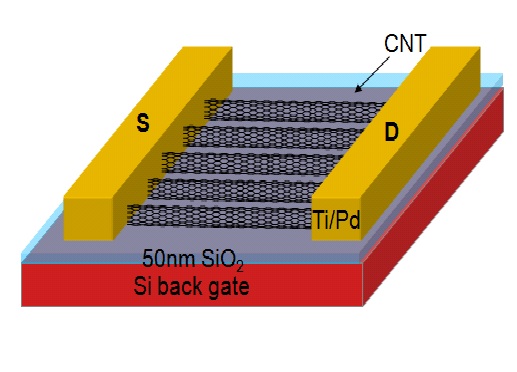Researchers in California managed to build a synapse from carbon nanotubes

Engineering researchers from the University of Southern California have achieved an important breakthrough in the use of nanotechnologies for the construction of a synthetic brain. The researchers were able to build a synapse from carbon nanotubes whose behavior in their experiment resembled the function of a neuron - the building block of the brain.
The research team, led by Professor Alice Parker and Professor Chongwu Zhou from the School of Engineering at the University of Southern California, used an interdisciplinary approach that combines electrical circuit design with nanotechnology to tackle the complex issue of mimicking brain activity. The researchers were able to do this through the use of carbon nanotubes.
Carbon nanotubes are molecular structures of carbon with extremely small dimensions and a diameter one million times smaller than the diameter of the tip of a normal pencil. These nanotubes can be used in electrical circuits and function both as metallic conductors and as semi-conductors.
"This is a necessary first step in the overall process," said the researcher, who began investigating the possibility of developing a synthetic brain as early as 2006. "We wanted to answer the question: Is it possible to build an electrical circuit that will function as a neuron? The next step is even more complex - how can structures made of these circuits be created so that they can imitate the function of the brain made up of a hundred billion neurons, when each neuron is connected to ten thousand synapses?"
The researchers emphasize that the practical development of an artificial brain, or even a functional area in the brain, is decades out of reach, and that the next hurdle in the research is the focus on restoring the flexibility of the brain through the circuits. The human brain continuously produces new neurons, builds new connections and adapts throughout life, and imitating this process using alternative circuits would be a formidable task, according to the lead researcher.
The researchers believe that the ongoing research into understanding the process of human intelligence could have long-term applications ranging from the development of artificial nanotechnology that could heal head injuries to safe cars that could protect their drivers in entirely new ways.

12 תגובות
Eyal A:
I don't know what principle you are talking about, but my answer was directed to question 1, which spoke about the tip of a pencil and not the tip of a principle (or of a nanotube).
Michael,
Basically they were talking about nanotubes, that is, an existing diameter. The perimeter consists of many more than six carbon atoms. If you are talking about a point-shaped part, then technically it is possible to "sharpen" so that one atom remains at the end. And not only when it comes to carbon. But this is of course done with sophisticated equipment and for sophisticated equipment (scanning microscopes of various kinds - STM or AFM for example).
The tip cannot be smaller than one carbon atom.
In fact, since it is graphite, I assume that the tip must contain at least six carbon atoms arranged in a hexagonal shape.
However - I find it hard to believe that there is a technical possibility for such precise refinement.
to anonymous anonymous user (6)
At Chezile Warren talked about flying to the moon even then some laughed. When I was a child they talked about an imaginary reality where children in schools would learn with computers. And each child will have his own computer. Do not delude yourself that it is not possible to achieve what a person strives for. The capabilities even surpass the wildest imagination that exists today. It is well known that reality surpasses imagination.
A simple proof of this, see science fiction films made only about 60 years ago, how clumsy they are compared to today
Jonathan, you mean the size of a pixel.
The tip of the pencil has thickness.
The poet's intention is a standard pencil nib which is in the shape of a cylinder
which is half a millimeter
If, on the other hand, we accidentally assume that a pencil has a cone-shaped point
So because the space itself is discrete and not continuous
The tip of the pencil has a finite size
Haha, obviously they managed to build a brain, and right after that they finished building the spaceship that flies at the speed of light
There is no diameter for the tip of a pencil.
The tip itself is a point.
I will answer seriously, even if you laughed 🙂
The diameter of a pencil tip of a pencil pen is 0.5 millimeters, or 5 thousandths of a meter if we are talking about meters.
They talked about a millionth of that, let's say, so it's 5 thousandths of a meter divided by a million, which is 5 billionths of a meter.
A billionth of a meter is called a nanometer.
A tenth of a nanometer is an angstrom, so I think they are talking about a size of single angstroms, let's say 5 angstroms.
In the semiconductor industry, these are accepted dimensions... a tenth of a billionth of a meter 🙂
http://www.neuroinformatics2008.org/congress-movies/Henry%20Markram.flv/view
http://ditwww.epfl.ch/cgi-perl/EPFLTV/home.pl?page=start_video&lang=2&connected=0&id=365&video_type=10&win_close=0
I wanted to ask - what is the diameter of the tip of a regular pencil?
And do you mean a sharpened pencil or not?